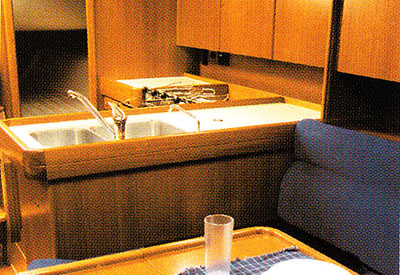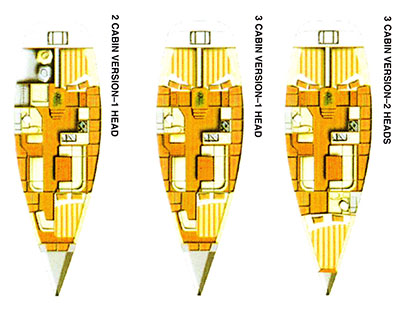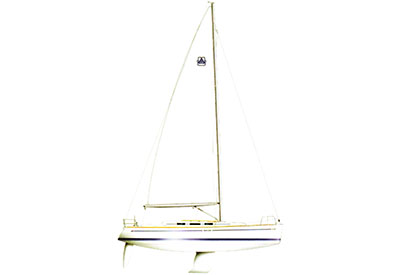Dufour 40
By Rob MacLeod
Photos by Bill Mcleod
The Dufour 40, recently named Boat of the Year in France, is the newest in the line of performance cruisers from Dufour Yachts of La Rochelle, France.
Modern design and state of the industry construction techniques have combined to make this boat functional, fun and fast. Overall impressions of the Dufour 40 is that it will be as great around the buoys as it will be comfortable for a family cruise vacation.
ON DECK
The ability to move around the cockpit, get safely forward along the side decks and be secure on the foredeck is crucial. In racing mode, the optional cockpit table is removed and stowed below. The Dufour 40 comes standard with a double-ended mainsheet arrangement that leads to a wide traveler. Sheeted through Harken blocks, the mainsheet can easily be handled from the helm or coach roof winch. The traveler extends the width of the cabin sole, allowing for maximum boom adjustment and leech control.
Primary winches are set just forward of the wheel, within reach of the helm. Jammer cleats on the Harken double genoa turning blocks allow for temporary re-allocation of the primary winch to traveler, spinnaker or guy pole control.
 The cockpit easily accommodates six adults. The helm seat stretches across the transom and can seat two or three adults. The drop down helm seat is substantial although moving the seat in and out of position takes two hands – best done before leaving the dock or at least in flat water.
The cockpit easily accommodates six adults. The helm seat stretches across the transom and can seat two or three adults. The drop down helm seat is substantial although moving the seat in and out of position takes two hands – best done before leaving the dock or at least in flat water.
The large wheel has a low profile. A cutout in the cockpit sole conceals the lower part of the wheel. The leather cover comes in handy on a cold day. The steering pod is slim with matching wind and speed instruments mounted on both sides of the structure – readily available to both skipper and crew. Although instruments are not visible when standing behind the wheel, a GPS screen or plotter can easily be added to the upper binnacle handrail.
Moving forward, the side decks are wide and free of obstruction. The genoa tracks are set well inboard, as are the shrouds. The coach roof is low allowing a clear sightline forward.
The teak grab rails and toe rails seem substantial and are well placed to keep the crew on deck where they belong. The foredeck is clean, clear and safe, with ample space for foredeck crew to move around. The anchor locker (with electric windlass) is flush.
BELOW DECK
Below deck is a clean, efficient and effective layout. The fit and finish of installations, cabinets and galley seems more than adequate for a performance cruiser. In the galley, counter space is reasonable, although not overly abundant. The rails around the counter are high and will keep articles where put and also serve as a good handhold.
 The propane stove has two burners. The rail and fiddles seem strong enough to hold a pot of pasta in place permanently. The oven is small, but large enough to heat up a pan of lasagna during an overnight race. The top loading Frigomatic refrigeration will keep things cool, but without some modification, will not keep anything frozen for long.
The propane stove has two burners. The rail and fiddles seem strong enough to hold a pot of pasta in place permanently. The oven is small, but large enough to heat up a pan of lasagna during an overnight race. The top loading Frigomatic refrigeration will keep things cool, but without some modification, will not keep anything frozen for long.
The main saloon is roomy and open. The deck stepped mast sits on the main bulkhead with a blended in compression post. On the port side, the salon table morphs into a cozy double. Fully extended, there is seating for six adults. Bolsters extend to catch the back of the knee of this long legged reviewer – very comfortable.
The saloon is well lit with long fixed windows. There are large opening ports on either side of the galley each with 4 dogs along the bottom to ensure a watertight fit. The large deck hatch (with privacy blinds) also contributes to the openness and airy feeling of the interior.
The cabin sole is varnished Moabi veneer marine ply. Access covers are well placed out of main traffic areas. Lockers are double latched and cabin doors have double anti-vibration bolts. Another nice touch is the ability to unship the cabin doors to gain better access for cleaning and maintenance.
The navigation station is well laid out. The chart table is large enough to plot on a folded chart. Instruments are set at an angle so they can be read while seated or from the side by the back seat navigator. Detail in the power distribution panel is impressive.
The Dufour 40 has three cabin arrangements. Two have three sleeping cabins (two aft and one forward). Our review boat came with two. The forward berth will undoubtedly be claimed by the owner for its size, accessibility and ventilation. The aft cabin has good stowage space with several lockers that drain into the bilge.
 The boat’s three batteries are accessed from the aft cabin and are tied down with web straps. The brackets for the straps seem undersized and are screwed into plywood. I’d replace the screws with bolts and backing plates. I also add an additional locking device to the door to ensure proper ventilation through the engine compartment.
The boat’s three batteries are accessed from the aft cabin and are tied down with web straps. The brackets for the straps seem undersized and are screwed into plywood. I’d replace the screws with bolts and backing plates. I also add an additional locking device to the door to ensure proper ventilation through the engine compartment.
The head and separate shower area seem quite functional, with the shower area serving as a large wet locker. Clean up after a race or cruise will not become a contortionist ‘s challenge. Good headroom (6’6″) carries through the entire boat.
DESIGN AND CONSTRUCTION
The hull is hand-laminated fiberglass with vacuum bagged PVC foam core above the waterline. The deck is built with two moulds and an injected resin transfer process resulting in a 30% lighter, yet stronger deck. The boat is designed and built to the Bureau Veritas (BV) standard – a European standard of quality.
Dufour warrants hull integrity for 10 years, including coverage for blistering of all underwater surfaces, except the keel and rudder. The warranty is transferable to subsequent owners. However, Dufour may request an inspection to ensure the selling owner has maintained the hull properly. The Dufour 40 is classified as a CE Off-shore Category “A” ocean going boat.
ENGINE AND SYSTEMS
The boat is powered by a 40 hp Volvo Penta saildrive. Adequate access to the engine compartment is through the aft cabin and companionway ladder. Easy access to oil dip stick is through an inspection port in the shower area. Boasting both active and passive ventilation, thick foam and leaded rubber insulation protects the crew from excess engine noise and fumes. The three-point engine mount reduces vibration and since Volvo supplies the engine bed along with the engine, the integrity of the auxiliary power system is maintained. The saildrive installation is quiet and relatively vibration free. The boat is equipped with one 100-amp hour engine starting battery isolated from the two 100-amp hour house batteries.
UNDER POWER
The Volvo saildrive has adequate power. I took the boat through its paces and was impressed with the power to start and stop the boat. It can be turned around (three-point turn) in a crowded marina. A look at the boat’s profile indicates why this is so. Our review boat was fitted with the optional 6’11” keel. This provides an excellent pivot point. The long semi-elliptical rudder is set well aft giving the turning force great leverage. The relatively flat hull offers little resistance and the sail drive is located about six feet forward of the rudder, allowing an undisturbed flow of water to push against the rudder.
UNDER SAIL
The Dufour 40 maximizes its water line with a near vertical entry and a unique flare to the hull just behind the stem. We were able to reach hull speed in moderate air on a reach with the asymmetrical spinnaker.
The Dufour 40 comes standard with 958 square feet (89 m2) of sail. The large genoa clears the foredeck easily and the boat can readily be single or short-handed. The optional adjustable genoa tracks worked well for changing lead angle while underway. Genoa tension always wants to pull the genoa car aft, so a 4:1 block is used to pull it forward to tighten the leech and open the foot in light and or lumpy conditions. The car slides back to depower the genoa in heavier air.
Review conditions were in the 8- 12 knot range. The boat accelerated quickly to 5-5.5 knots close hauled. The large wheel balanced well with little weather helm.
Sail handling was never a chore. The main sail attaches to the mast with roller cars, each with four separate rollers to spread the load. Our review boat came with an Elvestrom main and genoa and an optional Quantum cruising spinnaker. The main is fully battened, ensuring proper shape on all points of sails. The two reefs were single line led to the coach roof. An innovation was turning blocks sewn into the reef tack and clew points virtually eliminating friction. The entire reefing process is easier with no need to leave the cockpit.
IN CONCLUSION
The Dufour 40 is an impressive boat in both form and function. There is little on the boat that is not needed, and nothing I wanted seemed to be missing. In addition, the crew at Dufour Canada in Port Credit know their stuff. The knowledge and attention to detail of Ken Johnson and the rest of the Dufour Canada crew indicate the experience should be as satisfying as the Dufour 40 itself.
Rob is a speaker, facilitator, author and sailor. Rob now works with organizations to improve performance and results by applying lessons gained from sailing.
Originally published in Canadian Yachting’s June/July 2003 issue.
DUFOUR 40 SPECIFICATIONS
LOA: 40 ft. 8 in.
LWL: 35 ft. 2 in.
Beam: 12 ft. 10 in.
Draft (shoal/deep): 5 ft. 3 in./ 6’11 in.
Displacement (deep draft): 16,133 lbs.
Ballast (shoal/deep): 5,967 lbs.
Sailarea (main and jib): 958 sq.ft.
Power: Volvo Penta 40 HP Saildrive
Fuel/water/waste: 42 gal./92 gal.
Designer: Umberto Felci
Deck layout: Patric Roseo
Current Base Price (including cruising package): $263,300 (2003)
As Sailed: including commissioning package, electronics Package, full-batten main and lazy bag, asymmetrical spinnaker, genoa lead adjusters, upgraded coach roof winches, cockpit table and deep draft keel: $298,305






















